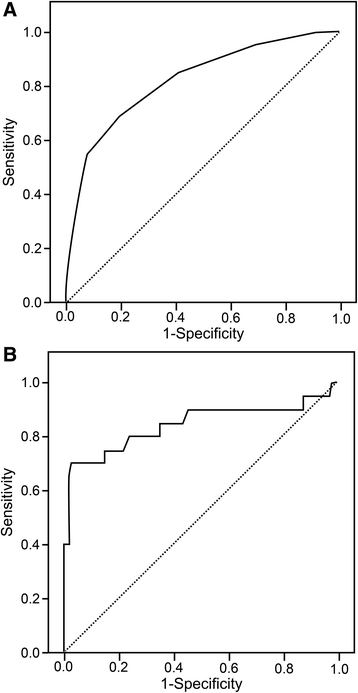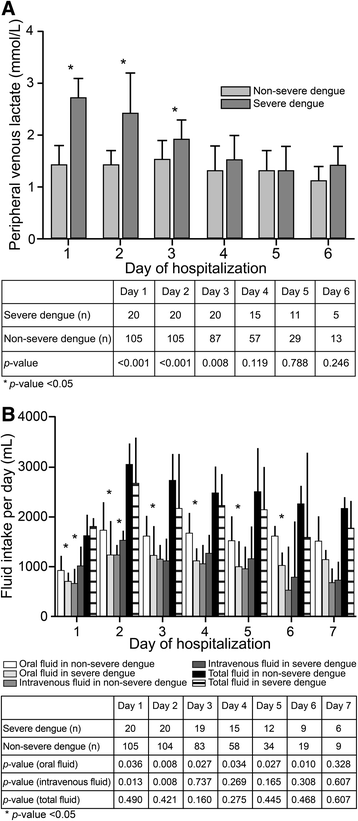Diagnostic accuracy of peripheral venous lactate and the 2009 WHO warning signs for identifying severe dengue in Thai adults: a prospective observational study
- PMID: 26832147
- PMCID: PMC4736485
- DOI: 10.1186/s12879-016-1386-5
Diagnostic accuracy of peripheral venous lactate and the 2009 WHO warning signs for identifying severe dengue in Thai adults: a prospective observational study
Abstract
Background: Dengue is the most common mosquito-borne viral disease in humans. However, the sensitivities of warning signs (WSs) for identifying severe dengue in adults are low, and the utility of lactate levels for identifying severe dengue in adults has not been verified. Therefore, we aimed to evaluate the diagnostic accuracy of using peripheral venous lactate levels (PVL), as well as WSs established by the World Health Organization, for identifying severe dengue.
Methods: We prospectively evaluated individuals hospitalized for dengue who were admitted to the Hospital for Tropical Diseases in Thailand between May 2013 and January 2015. Blood samples to evaluate PVL levels were collected at admission and every 24 h until the patient exhibited a body temperature of <37.8 °C for at least 24 h. Data were recorded on a pre-defined case report form, including baseline characteristics, clinical parameters, and laboratory findings.
Results: Among 125 patients with confirmed dengue, 105 (84.0%) patients had non-severe dengue, and 20 (16.0%) patients had severe dengue. The presence of clinical fluid accumulation as a WS provided high sensitivity (75.0%, 95% confidence interval [CI]: 50.9-91.3%) and specificity (90.5%, 95% CI: 83.2-95.3%). The PVL level at admission was used to evaluate its diagnostic value, and receiver operating characteristic curve analysis revealed an area under the curve of 0.84 for identifying severe dengue. At the optimal cutoff value (PVL: 2.5 mmol/L), the sensitivity and specificity were 65.0% (95% CI: 40.8-84.6%) and 96.2% (95% CI: 90.5-99.0%), respectively. A combined biomarker comprising clinical fluid accumulation and/or PVL of ≥2.5 mmol/L provided the maximum diagnostic accuracy for identifying severe dengue, with a sensitivity of 90.0% (95% CI: 68.3-98.8%) and a specificity of 87.6% (95% CI: 79.8-93.2%).
Conclusions: Clinical fluid accumulation and/or PVL may be used as a diagnostic biomarker of severe dengue among adults. This biomarker may facilitate early recognition and timely treatment of patients with severe dengue, which may reduce dengue-related mortality and hospital burden.
Figures



Similar articles
-
Serum Procalcitonin and Peripheral Venous Lactate for Predicting Dengue Shock and/or Organ Failure: A Prospective Observational Study.PLoS Negl Trop Dis. 2016 Aug 26;10(8):e0004961. doi: 10.1371/journal.pntd.0004961. eCollection 2016 Aug. PLoS Negl Trop Dis. 2016. PMID: 27564863 Free PMC article.
-
Identification of clinical factors associated with severe dengue among Thai adults: a prospective study.BMC Infect Dis. 2015 Oct 14;15:420. doi: 10.1186/s12879-015-1150-2. BMC Infect Dis. 2015. PMID: 26468084 Free PMC article.
-
Plasma cell-free DNA: a potential biomarker for early prediction of severe dengue.Ann Clin Microbiol Antimicrob. 2019 Mar 13;18(1):10. doi: 10.1186/s12941-019-0309-x. Ann Clin Microbiol Antimicrob. 2019. PMID: 30871553 Free PMC article.
-
A Two-Year Review on Epidemiology and Clinical Characteristics of Dengue Deaths in Malaysia, 2013-2014.PLoS Negl Trop Dis. 2016 May 20;10(5):e0004575. doi: 10.1371/journal.pntd.0004575. eCollection 2016 May. PLoS Negl Trop Dis. 2016. PMID: 27203726 Free PMC article. Review.
-
Predictive markers for the early prognosis of dengue severity: A systematic review and meta-analysis.PLoS Negl Trop Dis. 2021 Oct 5;15(10):e0009808. doi: 10.1371/journal.pntd.0009808. eCollection 2021 Oct. PLoS Negl Trop Dis. 2021. PMID: 34610027 Free PMC article.
Cited by
-
Prediction of mortality in severe dengue cases.BMC Infect Dis. 2018 May 21;18(1):232. doi: 10.1186/s12879-018-3141-6. BMC Infect Dis. 2018. PMID: 29783955 Free PMC article.
-
MicroRNA 573 Rescues Endothelial Dysfunction during Dengue Virus Infection under PPARγ Regulation.J Virol. 2022 Mar 23;96(6):e0199621. doi: 10.1128/jvi.01996-21. Epub 2022 Mar 23. J Virol. 2022. PMID: 35108097 Free PMC article.
-
Serum Procalcitonin and Peripheral Venous Lactate for Predicting Dengue Shock and/or Organ Failure: A Prospective Observational Study.PLoS Negl Trop Dis. 2016 Aug 26;10(8):e0004961. doi: 10.1371/journal.pntd.0004961. eCollection 2016 Aug. PLoS Negl Trop Dis. 2016. PMID: 27564863 Free PMC article.
-
Clinical signs and symptoms associated with WHO severe dengue classification: a systematic review and meta-analysis.Emerg Microbes Infect. 2021 Dec;10(1):1116-1128. doi: 10.1080/22221751.2021.1935327. Emerg Microbes Infect. 2021. PMID: 34036893 Free PMC article.
-
Development of a Prognostic Prediction Model to Determine Severe Dengue in Children.Indian J Pediatr. 2018 Jun;85(6):433-439. doi: 10.1007/s12098-017-2591-y. Epub 2018 Jan 18. Indian J Pediatr. 2018. PMID: 29344875
References
-
- World Health Organization . Global strategy for dengue prevention and control 2012–2020. Geneva: WHO; 2012.
-
- World Health Organization . Comprehensive guidelines for prevention and control of dengue and dengue hemorrhagic fever. India: WHO; 2011.
-
- Wichmann O, Hongsiriwon S, Bowonwatanuwong C, Chotivanich K, Sukthana Y, Pukrittayakamee S. Risk factors and clinical features associated with severe dengue infection in adults and children during the 2001 epidemic in Chonburi, Thailand. Trop Med Int Health. 2004;9:1022–9. doi: 10.1111/j.1365-3156.2004.01295.x. - DOI - PubMed
Publication types
MeSH terms
Substances
LinkOut - more resources
Full Text Sources
Other Literature Sources
Research Materials

